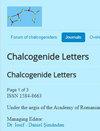酸处理制备高活性位CdS/g-C3N4异质结光催化剂
IF 1.2
4区 材料科学
Q4 MATERIALS SCIENCE, MULTIDISCIPLINARY
引用次数: 0
摘要
实现有机污染物高效降解的关键在于提高光催化剂中光生电子-空穴对的分离效率。这里,通过浓酸蚀刻和剥离来破坏g-C3N4层之间的氢键,以获得更分散、更轻的g-C3N4-纳米片结构,然后通过水热法将CdS球形纳米颗粒分散在g-C3N4/纳米片上。通过测试不同负载量的复合光催化剂的降解性能,确定了CdS在g-C3N4纳米片上的最佳负载量。使用配备420nm截止滤光片的700-800W氙灯模拟阳光测试了MB的降解性能,结果表明,7%CdS/g-C3N4光催化剂对MB的降解率为90.7%。结果表明,CdS纳米颗粒的浓酸处理和负载可以显著提高g-C3N4纳米片的光催化活性,这归因于负载CdS增强了g-C3N4的转换功能,增强了g-C3N4在可见光下的响应范围和能力,并通过负载CdS提高了光生电子-空穴对分离率,从而提高了复合材料的光催化性能。本文章由计算机程序翻译,如有差异,请以英文原文为准。
Preparation of CdS/g-C3N4 heterojunction photocatalyst with high activity sites by acid treatment
The key to achieve efficient degradation of organic pollutants lies in improving the separation efficiency of photogenerated electron-hole pairs in photocatalysts. Here, the hydrogen bonds between g-C3N4 layers were broken by concentrated acid etching and exfoliation to obtain a more dispersed and lighter g-C3N4 nanosheet structure, and then the CdS spherical nanoparticles were dispersed on g-C3N4 nanosheets by hydrothermal method. The optimal loading of CdS on g-C3N4 nanosheets was determined by testing the degradation performance of the composite photocatalysts with different loading amounts. The degradation performance was tested by simulating sunlight using a 700-800 W xenon lamp equipped with a 420 nm cut-off filter, which showed that the degradation of MB by 7% CdS/g-C3N4 photocatalyst was 90.7% for MB. It indicates that concentrated acid treatment and loading of CdS nanoparticles can significantly improve the photocatalytic activity of g-C3N4 nanosheets, which is attributed to the enhancedup conversion function of g-C3N4 by loading CdS to enhance the response range and ability of g-C3N4 in visible light and the photogenerated electron-hole pair separation rate by loading CdS, thus improving the photocatalytic performance of the composite.
求助全文
通过发布文献求助,成功后即可免费获取论文全文。
去求助
来源期刊

Chalcogenide Letters
MATERIALS SCIENCE, MULTIDISCIPLINARY-PHYSICS, APPLIED
CiteScore
1.80
自引率
20.00%
发文量
86
审稿时长
1 months
期刊介绍:
Chalcogenide Letters (CHL) has the aim to publish rapidly papers in chalcogenide field of research and
appears with twelve issues per year. The journal is open to letters, short communications and breakings news
inserted as Short Notes, in the field of chalcogenide materials either amorphous or crystalline. Short papers in
structure, properties and applications, as well as those covering special properties in nano-structured
chalcogenides are admitted.
 求助内容:
求助内容: 应助结果提醒方式:
应助结果提醒方式:


